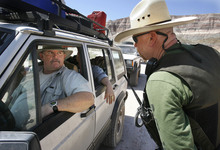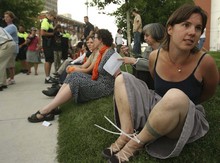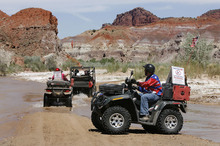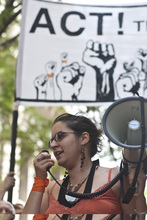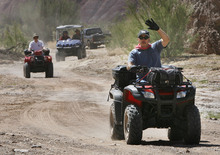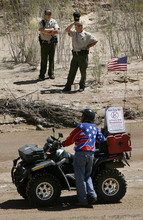This is an archived article that was published on sltrib.com in 2014, and information in the article may be outdated. It is provided only for personal research purposes and may not be reprinted.
In much of rural Utah, the question isn't whether you're frustrated with federal land managers but what are you going to do about it. And as a result, conservatives are contemplating acts of civil disobedience, especially after the armed standoff with the Bureau of Land Management in Bunkerville, Nevada, involving rancher Cliven Bundy.
But don't think this is a new thing. Here are five instances where protesters bent, if not broke, the law in the state's protracted battle over the use of federal land:
—
Seep Ridge Road, July 2013

About 50 environmentalists overwhelmed a road project and temporarily interrupted the operations at a mine to protest a tar-sands development in the Book Cliffs region of southeast Utah that is expected to gear up in 2014.
Uintah County Sheriff's deputies observed the protest but didn't arrest or cite any of the participants, some of whom chained themselves to heavy equipment. Others, affiliated with the groups Canyon Country Rising Tide and Peaceful Uprising, carried large banners reading "Tar sands wreck our lands," and "If you build it we will come."
These protesters are upset that Calgary-based-U.S. Oil Sands received a strip-mine permit on land controlled by the Utah School and Institutional Trust Lands Administration. The oil-rich sands are expected to be refined in Salt Lake City.
—
Paria River ride, May 2009

Kane County Commissioner Mark Habbeshaw said he was "mad as hell" and wasn't going to take it any more to the cheers of 300 ATV riders that he led down the muddy stream known as the Paria River, which the Bureau of Land Management lists as closed to motorized vehicles. The Paria River is part of the Grand Staircase-Escalante National Monument and for years ATV enthusiasts had ridden the river bottom.
Protesters, including state Rep. Mike Noel, R-Kanab, were angry that BLM planned to enforce the ban and they argued that many of these rural roads and pathways should be under state control.
BLM employees took pictures of the protesters and wrote down license-plate numbers, then forwarded the information to the U.S. Attorney's Office. No one was ever charged or cited, but protest organizers were still irritated by the actions of the BLM.
"We felt like that was pretty low," said Shawna Cox, protest organizer. "We thought we were living in a Communist country."
—
Bidder 70, December 2008

Tim DeChristopher was an active bidder during an oil and gas auction held by the BLM, claiming 14 leases that he never intended to pay for or actually use. The act of civil disobedience by the climate activist ultimately cost him his freedom. He was convicted of two felonies and spent 21 months in custody.
At his sentencing, U.S. District Judge Dee Benson said he based part of the sentence on DeChristopher's continued defiance and his support of civil disobedience. While Benson was handing down his verdict, 26 members of Peaceful Uprising, a group DeChristopher helped create, blocked a street in downtown Salt Lake City and were arrested.
DeChristopher was released in 2013 and remains on probation.
Federal officials in the Obama administration ultimately invalidated the leases offered during the auction, which were pushed through the system in the waning days of the Bush administration.
—
Standoff over signs, August 2003

Ever since President Bill Clinton created the Grand Staircase-Escalante National Monument in 1996, counties and environmental groups have waged a fight over access to roads and walkways, most of which remain closed to motorized use.
Kane County Commissioner Mark Habbeshaw, Sheriff Lamont Smith and other county officials took their battle out of the courtroom in the fall of 2003, removing dozens of 4-foot-tall markers prohibiting ATV and motorcycles on the routes. They took the signs and dumped them in front of the monument's headquarters in Kanab, then demanded that other signs be removed.
Two years later, the same bunch put up their own county signs saying the routes were open for use, often placing them next to restored federal signs saying the routes were closed. The BLM never took definitive action and the U.S. Attorney never brought charges. Instead, the Southern Utah Wilderness Alliance brought a lawsuit against the county. A federal judge issued an injunction in 2008 and the county eventually removed the signs.
—
Bloody Mary and Fiftymile Mountain, November 2000
Due to drought, BLM authorities ordered ranchers to remove their cattle from grazing land in the Grand Staircase-Escalante National Monument earlier than normal, but "Bloody Mary" Bulloch and a few other ranchers refused to budge, believing the feds were using the lack of rain as an excuse to get rid of them.
The BLM rounded up Bulloch's cattle and impounded them in Salina. Not long after, Bulloch and a small posse forced their way into the federal pen and freed her animals, some of which she said were injured as a result of the federal actions. She decapitated one of her animals and hung its head on the side of her big cattle truck. She parked the monstrosity in front of the national monument's headquarters with a sign directed at the monument's manager. It read: "Direct Result of Kate Cannon's Grazing Management Plan."
—
Live debate: Managing federal lands in Utah
I On May 14 at 7 p.m., The Tribune's Jennifer Napier-Pearce will moderate an Oxford-style debate between three Utahns in support of current federal lands policy and three in opposition.
Once the two sides have debated, the live audience will choose a winner.
The debate is free and open to the public at the Salt Lake City Main Library, 210 E. 400 South. KCPW 88.3/105.3 FM will broadcast it live, and it also will be streamed live at sltrib.com.












